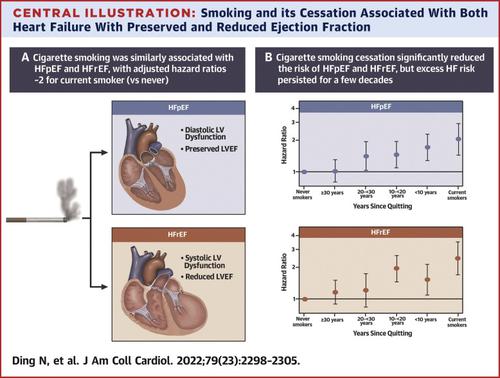Journal of the American College of Cardiology ( IF 21.7 ) Pub Date : 2022-06-06 , DOI: 10.1016/j.jacc.2022.03.377 Ning Ding 1 , Amil M Shah 2 , Michael J Blaha 3 , Patricia P Chang 4 , Wayne D Rosamond 5 , Kunihiro Matsushita 3

|
Background
Smoking is well-recognized as a risk factor for heart failure (HF). However, few studies have evaluated the prospective association of cigarette smoking and smoking cessation with heart failure with preserved ejection fraction (HFpEF) and heart failure with reduced ejection fraction (HFrEF) as distinct phenotypes.
Objectives
The aim of this study was to quantify the association of cigarette smoking and smoking cessation with the incidence of HFpEF and HFrEF.
Methods
In 9,345 ARIC (Atherosclerosis Risk In Communities) study White and Black participants without history of HF at baseline in 2005 (age range 61-81 years), we quantified the associations of several established cigarette smoking parameters (smoking status, pack-years, intensity, duration, and years since cessation) with physician-adjudicated incident acute decompensated HF using multivariable Cox models.
Results
Over a median follow-up of 13.0 years, there were 1,215 incident HF cases. Compared with never smokers, current cigarette smoking was similarly associated with HFpEF and HFrEF, with adjusted HRs ∼2. There was a dose-response relationship for pack-years of smoking and HF. A more extended period of smoking cessation was associated with a lower risk of HF, but significantly elevated risk persisted up to a few decades for HFpEF and HFrEF.
Conclusions
All cigarette smoking parameters consistently showed significant and similar associations with HFpEF and HFrEF. Smoking cessation significantly reduced the risk of HF, but excess HF risk persisted for a few decades. Our results strengthened the evidence that smoking is an important modifiable risk factor for HF and highlighted the importance of smoking prevention and cessation for the prevention of HF, including HFpEF.
中文翻译:

保留和减少射血分数的吸烟、戒烟和心力衰竭风险
背景
吸烟被公认为心力衰竭 (HF) 的危险因素。然而,很少有研究评估吸烟和戒烟与射血分数保留的心力衰竭(HFpEF)和射血分数降低的心力衰竭(HFrEF)作为不同表型的前瞻性关联。
目标
本研究的目的是量化吸烟和戒烟与 HFpEF 和 HFrEF 发生率的关系。
方法
在 9,345 名 ARIC(社区动脉粥样硬化风险)研究中,2005 年基线时没有 HF 病史的白人和黑人参与者(年龄范围 61-81 岁),我们量化了几个既定的吸烟参数(吸烟状态、包年、强度)之间的关联、持续时间和停药后的年数)与医生裁定的事件急性失代偿性心衰使用多变量 Cox 模型。
结果
在 13.0 年的中位随访期间,共有 1,215 例心衰病例。与从不吸烟者相比,当前吸烟与 HFpEF 和 HFrEF 的相关性相似,调整后的 HRs 约为 2。吸烟包年数和心衰之间存在剂量反应关系。更长时间的戒烟与较低的 HF 风险相关,但 HFpEF 和 HFrEF 的风险显着升高持续了几十年。
结论
所有吸烟参数始终显示出与 HFpEF 和 HFrEF 显着且相似的相关性。戒烟显着降低了心衰的风险,但过度的心衰风险持续了几十年。我们的研究结果强化了吸烟是 HF 的一个重要的可改变危险因素的证据,并强调了预防吸烟和戒烟对于预防 HF(包括 HFpEF)的重要性。











































 京公网安备 11010802027423号
京公网安备 11010802027423号